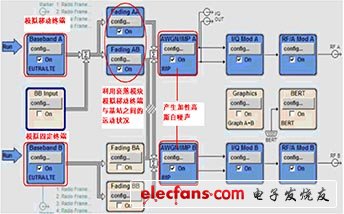According to the 3GPP specifications, LTE to LTE-A are currently divided into three versions, namely Release 8, Release 9, Release 10. That is to say, 3GPP introduced the LTE standard from Release 8; Release 9 adds a "location reference signal", a "broadcast multicast single frequency network", and a "dual stream beamforming" to the definition of the physical layer. "Other characteristics; in Release 10, the carrier layer has added features such as "carrier aggregation" and "shared channel clustering". LTE Release 10 is also called LTE-Advanced or LTE-A. For network equipment manufacturers, RF testing of devices such as base stations and repeaters uses vector signal sources and signal analyzers, both in the R&D phase and in the production phase. Taking the LTE base station radio frequency test as an example, the manufacturer uses the vector signal source to generate the LTE uplink signal, the analog terminal transmits the uplink signal to perform the receiving characteristic test and the performance test on the base station, and uses the signal analyzer to test the downlink signal radio frequency indicator transmitted by the LTE base station. For chip and terminal manufacturers, vector signal sources and signal analyzers are also used in the early stages of development. Similar to the base station test, the chip and the terminal manufacturer use the vector signal source to generate the LTE downlink signal, and simulate the base station's transmission signal, which is used to test the terminal's receiving sensitivity and throughput rate. The signal analyzer is used to test the uplink signal RF indicator transmitted by the terminal. It can be seen that the vector signal source and signal analyzer are widely used in the RF test of LTE and LTE-A equipment as a general-purpose RF test instrument. 2 LTE and LTE-A signal generation scheme The above mentioned that it is necessary to generate an LTE/LTE-A uplink or downlink signal using a vector signal source to test the reception performance of the LTE device. Based on the 3GPP LTE/LTE-A specification document, the following briefly introduces how to use the R&S signal source SMU200A to generate LTE/LTE-A test signals. First, the LTE Release 8 network device RF test is taken as an example, and the test is mainly performed according to Chapters 7 and 8 of the specification 3GPP 36.141. Among them, the seventh chapter is the base station receiving test, which requires the signal source to generate useful LTE signal, white noise signal and interference signal. The signal source SMU200A can simultaneously realize all three signals required in one source. The eighth chapter belongs to the performance test part of the base station. It mainly examines the performance of the base station in the typical fading scenario and the functions of hybrid automatic retransmission. Taking the 3GPP 36.141 8.2.2 "uplink delay adjustment" test example as an example, the background of the test case is to input two analog terminal signals into the base station, one of which is a fixed terminal, the other is a mobile terminal, and the mobile terminal and the mobile terminal The delay between the base stations is constantly changing. In order to correctly receive the data packets transmitted by the mobile terminal, the base station needs to transmit the hybrid automatic repeat (HARQ) information to the mobile terminal, and the mobile terminal performs the feedback signal according to the base station. The transmission time is automatically adjusted, and the signals of the two terminals are loaded with an additive white Gaussian noise signal. At this time, whether the change of the throughput rate of the base station satisfies the specification requirements is observed. The test block diagram given by 3GPP is shown in Figure 1. Figure 1 Uplink delay adjustment test case connection block diagram According to Figure 1, to complete the test, two signal sources, one analog fixed terminal and one analog mobile terminal are required, and the signal source of the analog mobile terminal needs to be able to receive the HARQ information sent by the base station and respond correctly; A noise signal generator for generating a noise signal; a fading simulator for simulating a delay variation characteristic between the mobile terminal and the base station. The R&S signal source SMU200A has a high degree of integration, enabling two independent signal transmissions within a single source, and simulating fading characteristics and additive white Gaussian noise signals within the source, ie, internal implementation of a single source. All of the above features. The configuration interface for testing the uplink delay adjustment of a single signal source SMU200A is shown in Figure 2. Figure 2 SMU200A test uplink delay adjustment configuration interface
Outdoor Led screen Kiosk as led poster is a very effective, eye-catching medium which can be fabricated as per the requirement of the application. A Outdoor Led Poster or Led screen kiosk in a standee with has an in-built player connected to the screens which can be updated from any remote location by using digital signage software. This medium can be used to welcome guests, advertise products as well as disseminate important information relevant to its viewers.
outdoor led screen Kiosk can have multiple led screens connected. The led screen poster can be used for advertisement but also the whether information and other tasks like online surfing, bill payments, shopping, etc for its users.
Outdoor Led Poster,Floor Standing Outdoor Led Poster,Outdoor Mobile Led Poster,Outdoor Led Flag Screen Shenzhen Priva Tech Co., Ltd. , https://www.privaled.com

LTE and LTE-A signal generation scheme
< p> 1 Introduction